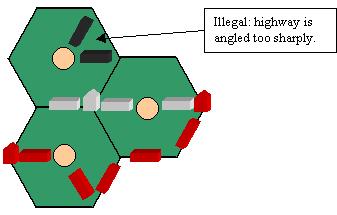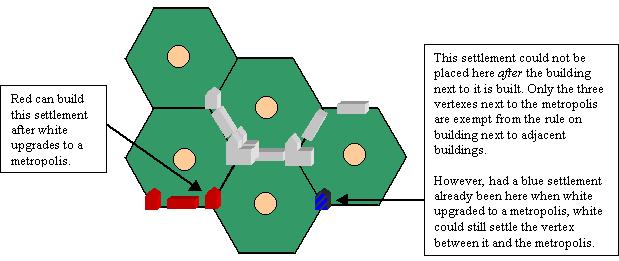 New Siedler von Catan Structures
New Siedler von Catan Structures New Siedler von Catan Structures
New Siedler von Catan Structures
Super Siedler |
New Structures |
Entdecker Structures |
New Cost Card |
Entdecker Cost Card |
A bridge crosses sea hexes and/or the edges where sea hexes meet to connect two vertexes touching land hexes. Bridges are represented on the map by the same pieces used to represent roads, but it always requires more pieces to build a bridge of a certain length than would be required for the same length of road. This means that building a bridge reduces the maximum length of road that one can achieve. There is a 1 point bonus to the player with the longest bridge (in case of a tie the first player to get the bonus keeps it.) This bonus is given even for a bridge of length one.
The segments of a bridge count towards the length of a road when determining the longest road, even if the bridge is earning the bonus point for being the longest one on the board.
A one segment long bridge requires two brick and a wood to build, and is represented by two road pieces. It must cross an edge where two sea hexes meet, with each end at a vertex touching a land hex.

Bridges that are two or more segments long must either bisect sea hexes or cross edges where two sea hexes meet, and can only be built in a straight line. A bridge's length is one for each edge it crosses, plus two for each hex it bisects. The cost is that of a one-segment bridge, plus one brick and one ore for each additional segment of length.

The endpoints of a bridge must touch land; it is not possible to partially construct a bridge and finish it on a later turn. The bridge is represented by a staggered series of road pieces that always number one less than twice the length traversed (i.e. three for two lengths, five for three, seven for four, etc.) The following figure provides examples of valid and invalid bridge constructions.

A highway provides a quick way across a hex, allowing one to connect two opposite vertexes with fewer road pieces than normally required, or to bypass opponents' settlements that might otherwise block road construction. A highway is represented by two road pieces, and counts as two lengths of road when determining the longest road. It must cross a hex by connecting vertexes at least two vertexes away from each other around the perimeter of the hex (i.e. it cannot angle sharply and connect two adjacent hexes.) It costs one wood, two brick and two wheat to build.

A highway must be built in its entirety in one turn; it is not possible to pay for half of it and place only one road piece. Once one player has built a highway across a hex, no other player may do so. Highways can coexist with normal roads around the edges of the hex. The following figure provides examples of valid and invalid highway constructions.

A metropolis is created by upgrading a city. It is represented on the map with two city pieces placed side by side. A metropolis is worth 4 points, and allows one to draw three raw material cards when the number of a hex adjacent to the metropolis is rolled. In addition, a metropolis has the effect of freeing up the three adjacent vertexes for construction of settlements. That is, any player can always build a settlement on any of the three vertexes adjacent to a metropolis, disregarding the rule that forbids adjacent settlements. These settlements can later be upgraded to cities or metropolises.
A metropolis costs three wheat and five ore.

The following figure provides an example of a metropolis.

Super Siedler |
New Structures |
Entdecker Structures |
New Cost Card |
Entdecker Cost Card |
 This page by Steve Barrera 2001-2013
This page by Steve Barrera 2001-2013